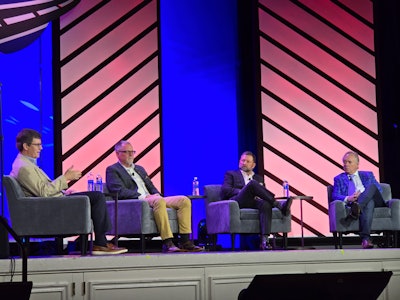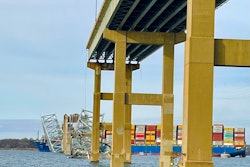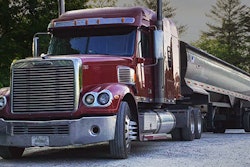
Driven by a combination of strategic expansions, market consolidation, operational, financial and regulatory factors, mergers and acquisitions in the trucking industry foster growth and value. But according to the Harvard Business Review, between 70-90% of acquisitions either fail or underdeliver.
“If you’re going to do an acquisition, you better make sure you know what you’re going after,” Murray Mullen, chair, senior executive office and president of Mullen Group, said during a panel on Monday morning at the Truckload Carriers Association annual convention in Nashville.
Having made several acquisitions over the years, Mullen admitted he’s made mistakes when he didn’t “do my homework,” and that it was when he was focusing only on growth benefits, rather than keeping strategy in mind. He said that carriers need to make sure their acquisition strategy is right, along with the timing of the acquisition.
With a lot of opportunities in the market, Mullen pointed out carriers need to have a long-term strategy. “Unfortunately, in this market, with interest rates so high, it’s really complicated to do acquisitions right now. The bid/ask is okay, but the cost of doing it is not,” Mullen said.
Merging companies often involves distinct organizational cultures. Bridging differences, aligning values and fostering collaboration is essential for successful post-merger integration.
Jim Richards, president and CEO of KLLM Transport Services, disagrees that it’s the market for acquisitions now, emphasizing on fortifying the culture they have cultivated. “We’re a very picky eater when it comes acquisitions,” he said. “We’re very careful with the culture that we have built, especially from a safety standpoint. The last thing you would want to do is introduce a bad actor into your culture.”
With three acquisitions over the years and having passed on “around a thousand” of opportunities, Richards said KLLM's strategy has been successful since a crucial factor they looked at is the culture fit. “You can get yourself into a real bind if the culture doesn’t match up,” he said.
Mark Rourke, president and CEO of Schneider National, believes that the period ahead for mergers and acquisitions is going to be attractive in 2024 and 2025. Having made acquisitions that resulted in good and bad results, Rourke said it’s important to learn from mistakes and identify what being successful looks like.
“[It’s about] chasing a well-run company. All you can really focus on is enhancing the customer that you can be an associate in experiencing, you don’t have to turn it around,” Rourke explained.
“As an acquirer, we have a legacy that we’ve created because they started a business. I think it matters where those companies go and it’s imperative for us to be a good steward of that legacy,” he added.
Managing insurance costs
Insurance costs have made a dent as a growing expense for carriers. Data from American Transportation Research Institute’s (ATRI) Operational Cost of Trucking report showed that truck insurance premiums have increased from 6.4 cents per mile in 2013, to 8.8 cents per mile in 2022.
Talking about the minimum insurance requirements of $750,000 to a proposed $5 million, Richards said it’s necessary and that with the cost of litigation today, one accident can exceed that total very quickly.
“I understand costs, however, there’s also a cost of not having it, and that can be detrimental. It’s scary if you’re running [with] a very low minimum,” Richards said.
Richards also talked about a frustration on insurance premiums – having paid for premiums for four years and never had a claim, the company received an increased pricing of 40%, he pointed out, “I want to pay insurance based on my performance, not on bad things that have happened in the industry.”
Rising issues
With elections coming up, the executives were asked to dive into political topics ranging from regulatory issues to the impact of legalization of marijuana by moderator Joey Hogan, president of Covenant Logistics Group.
The experts agree that regulations are bound to change depending on the winning administration.
While some regulations are good and necessary, Mullen said the whole ecosystem of regulations seems to be preventing companies from progressing and innovating.
“It takes away entrepreneurialism and the very essence of capitalism. They’re trying to move us to doing the exact same thing,” Mullen said.
Talking about legalized marijuana and its impact on the truck industry, Hogan pointed out ATRI’s report on how 41% of U.S. truck drivers reside in a jurisdiction where the adult use of marijuana is legal, though federal law still prohibits the use of recreational or medical marijuana for professional drivers.
The representatives said that it’s worth implementing hair follicle tests to identify habitual and lifestyle users.
Rourke suggested for carriers or companies who implement tests to add it to a national database to identify your brand as a drug-free company.
Having started hair testing seven years ago, Richards said it was difficult hiring drivers. Calling it a “leap of faith” in hindsight, Richard said it was one of the things they did for the company. Not only has it helped safety numbers, it reduced the process and time that frontline recruiters spent on dealing with people that probably ultimately won’t be able to work for the company.
Mullen agreed, and pointed out that small carriers should consider it, too.
The road to zero emissions
As the push for zero emission commercial vehicles gains traction, Richards noted that while his company supports EV regulations, timelines and capability are important factors to consider. “The technology is certainly not there for long haul at this point," he said. "But even if it does have capability, what will the cost be?”
In December 2023, Schneider National deployed 50 battery-electric Freightliner eCascadia trucks in Southern California. Running on a small use case basis, Rourke noted the carrier has since then passed 2 million miles in its battery-electric fleet.
Rourke said the distribution of power is the most difficult, with a three-year planning process. While drivers care and are positive about the issue, Rourke added, “This is a 10-year endeavor, regardless of what California thinks is feasible.”
“I think we’re on the cusp of major changing [landscape], but technology has to catch up with the philosophy and regulation,” said Mullen. “Wherever we land, is it going to cost us more and how do we pay for that? Is the technology going to help us be more efficient? I haven’t seen the magic bullet that reduces my costs.”
Mulled also pointed to the country’s reliance on oil and the need to look for alternative sources. “The U.S. is showing is its age in terms of energy efficiency. I’m an advocate of all forms and let it compete. Let’s be practical about this," he added.












